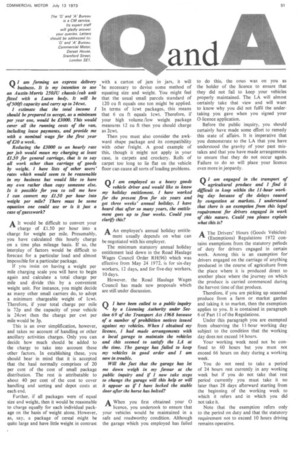n I am forming an express delivery business. It is
Page 53

If you've noticed an error in this article please click here to report it so we can fix it.
my intention to use an Austin-Morris 250.IU chassis /cab unit fitted with a Luton body. It will be of 500ft capacity and carry up to 24ewt.
I estimate that the total income I should be prepared to accept, as a minimum per year one, would be £3000. This would cover all the running costs of the van. including lease payments, and provide me with a nominal wage for the first year of £20 a week.
Reducing the £3000 to an hourly rate per job would mean my charging at least £1.50 for general carriage, that is to say all work other than carriage of goods by weight. I have lists of other users' rates which would seem to be reasonable in my business but would like to have my own rather than copy someone else. Is it possible for you to tell me how I can convert my £1.50 per hour into weight per mile? There must be some equation one could use or is it just a case of guesswork?
AIt would be difficult to convert your charge of fl...50 per hour into a charge for weight per mile. Presumably, you have calculated this hourly charge on a time plus mileage basis. If so, the interplay of factors would be difficult to forecast for a particular load and almost impossible for a particular package.
If you insist on having a weight per mile charging scale you will have to begin again and calculate a total charge per mile and divide this by a convenient weight unit. For instance, you might decide as many other small carriers do, to adopt a minimum chargeable weight of Icwt. Therefore, if your total charge per mile is 72p and the capacity of your vehicle is 24cwt then the charge per cwt per mile would be 3p.
This is an over simplification, however, and takes no account of handling or other ancillary activities charges. Only you can decide how much should be added to the charge to take into account these other factors. In establishing these, you should bear in mind that it is accepted that the haul normally comprises of 20 per cent of the cost of small package distribution. The rest is attributable to about. 40 per cent of the cost to cover handling and sorting and depot costs at each end.
Further, if all packages were of equal size and weight, then it would be reasonable to charge equally for each individual package on the basis of weight alone. However, as, say, a package of cereal might be quite large and have little weight in contrast with a carton of jam in jars, it will be necessary to devise some method of equating size and weight. You might feel that the usual small parcels standard of 120 cu ft equals one ton might be applied. In terms of Icwt packages, this means that 6 Cu ft equals Icwt. Therefore, if your high volume /low weight package measures 12 cu ft then you should charge as 2cwt.
Then you must also consider the awkward shape package and its compatibility with other freight. A good example of this, though it might not apply in your case, is carpets and crockery. Rolls of carpet too long to lie flat on the vehicle floor can cause all sorts of loading problems.
































































































